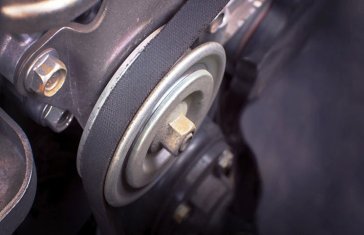When you decided you wanted to drive a Land Rover, the descriptive terms that came to mind likely included: strong, tough, durable, and elegant; all of which make Land Rovers especially unique cars. Luxury and elegance combined with function, comfort, and durability is rare in many European import cars; however, these singular cars can run into difficulty, just like every other manufactured vehicle on the road. The good news is that Land Rovers have a good track record when it comes to reliability.
With that being said, Land Rovers run into some specific issues that also set them apart from other vehicles, including accessory drive belt failure. The reasons for accessory drive belt failure vary depending upon driving habits, driving conditions, and the age of the vehicle. It’s important to be able to recognize the symptoms of drive belt failure in your Land Rover so that you can act preventively. In this article, we’ll go over what a drive belt does for your Land Rover’s engine, the common signs of failure, and what you can do in the future to keep problems from arising.
Drive Belt Function and Purpose
Also known as a serpentine belt, the accessory drive belt is comprised of a network of parts working together. Of course, if any of the other parts become compromised then it can lead to accessory drive belt failure. The drive belt is responsible for delivering adequate power to the other working components of your vehicle, mainly your engine. Since Land Rovers are especially larger vehicles, they need enough power to run optimally. When the drive belt fails, it cannot delineate the appropriate power to the various systems of the car.
Potential Reasons for Failure
Drive belt failure can be due to any number of issues, including simple manufacturing deficits in the specific model. As mentioned previously, driving habits and conditions, such as frequent short-distance drives, can also strain the drive belt over time, causing it to deteriorate quicker. Additionally, the material of the drive belt is exposed to harsh, ever-changing temperatures; this can cause the material to expand and contract, making it especially susceptible to cracks and tears.
Common Symptoms of Drive Belt Failure
Driving with a compromised drive belt can lead to serious engine damage and even failure. It’s critical to keep an eye out for concerning symptoms related to accessory drive belt health.
Noises
It’s most common to experience alarming noises coming from your engine when your drive belt moves off its designated alignment. Your Land Rover might be able to temporarily function; however, it is extremely risky to drive your car when the drive belt isn’t properly aligned. Belt misalignment can lead to the belt snapping or becoming damaged beyond repair, which will further damage your engine and significantly affect your car’s performance.
Problems with Power Steering
Your Land Rover was designed to protect itself from engine failure, which can certainly follow the event of a snapped accessory drive belt. Therefore, when the belt snaps or the car detects a problem, your car might present difficulty with the power steering function to inhibit drivability until the problem is addressed. Furthermore, your power steering might not be able to generate enough power to function due to a failed drive belt.
Engine Overheating
In addition to the other components of your Land Rover that are powered by the accessory drive belt, it also dominates the power delegated to your Rover’s cooling system. When your engine isn’t able to properly cool itself, engine overheating is usually what occurs next. An overheated engine commonly leaves drivers stranded on the roadside, and internal engine components damaged.

How We Can Help
The Land Rover experts at Cerrone’s European work proactively to address problem parts, including accessory drive belts, before they fail and cause further damage to our clients’ vehicles. We are known in Redwood City, CA for our expertise working with luxury European imports, including Land Rovers, and our foundational knowledge of common pitfalls in various vehicles’ design and engineering. When it comes to drive belt failure in Land Rovers, we know what to expect. If you’ve experienced any of the above-mentioned symptoms, it is critical to bring your Rover in for an inspection at the very least—it could keep you and your passengers safe, and save you thousands of dollars in repair work down the line. Please don’t hesitate to contact us directly to schedule an appointment or learn more about our shop.

 Mon – Fri: 8:00 AM – 5:00 PM
Mon – Fri: 8:00 AM – 5:00 PM 2306 El Camino Real Redwood City, CA 94063
2306 El Camino Real Redwood City, CA 94063 (650) 365-4145
(650) 365-4145
